A proposal for a 40-unit residential apartment building at 240 Greenwich Avenue was reviewed by Greenwich P&Z.
The application is filed under the state’s affordable housing statute 8-30g as “assisted housing.”
Under 8-30g, developments are exempt from local zoning except in instances of health and safety for which the bar is high.
This is the third application for John Fareri’s J Lofts West in the parking lot behind Bank of America. The first two applications were withdrawn.
This proposal is for a four-story building, plus two underground levels of parking.
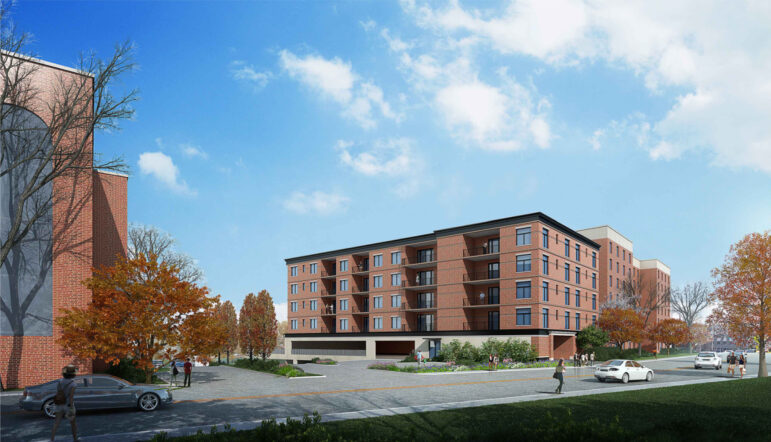

Other large 8-30g proposals have lately gone quiet including the Church Sherwood development (pictured), the Tranfo development on Benedict Place, and Waterfall Hollow at Pemberwick Rd and Comly Ave. It’s also been since January since Greenwich Woods explored with P&Z the idea of converting to 8-30g up on King Street.
Meanwhile the 5-story, 86-unit 8-30g at 5 Brookridge was withdrawn and the property owner Chris Franco has filed an application that would preserve the historic house and create just six units.
Back in May 2021 there was a pre application for just 18 units, of which three would be “affordable” as defined in Section 8-30g, and one would be a “moderate” income unit as defined in Section 6-110 of the Town’s Regulations.
That building would have been three stories plus one underground parking level. Neighbors testified in opposition, citing concerns about parking, floor area, traffic impact.
Then, in January 2022, a new pre application was filled for a six story building, plus two levels of underground parking, for 60-units and a total of 96 bedrooms. Of those, 18 units would have been designated affordable.
In response the P&Z commission suggested the applicant work with the Affordable Housing Trust Fund (AHTF), which they did.
This new pre-application reflects that effort.
Attorney John Tesei said the 40-unit proposal had been reduced from 60-units after consultation with the AHTF who agreed to a loan of $100,000. Eight units would be restricted for people earning no more than 80% of the Area Median Income (which is higher than State Median Income.)
The arrangement is not in perpetuity; it would expire in 40 years.
Bruce Cohen, attorney for the neighbors opposed to the development, balked at the $100,000 amount, saying that was low for a project of this size.
He also questioned how truly affordable the project was, given it’s rent and income are based on Area Median Income.
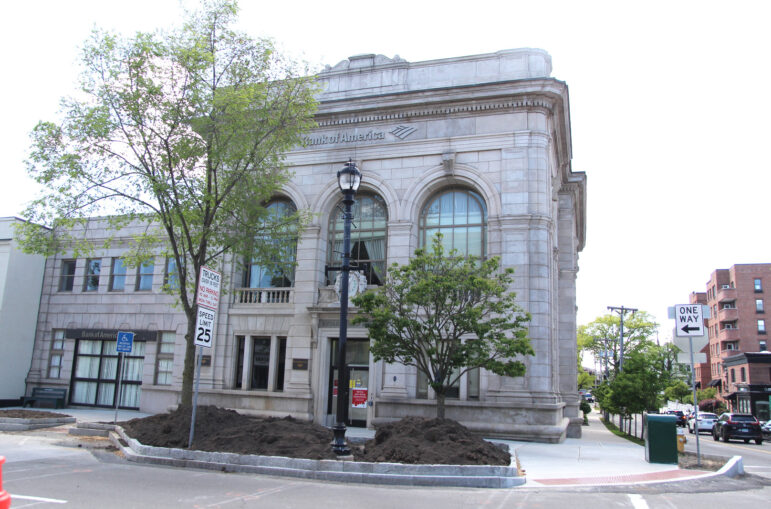
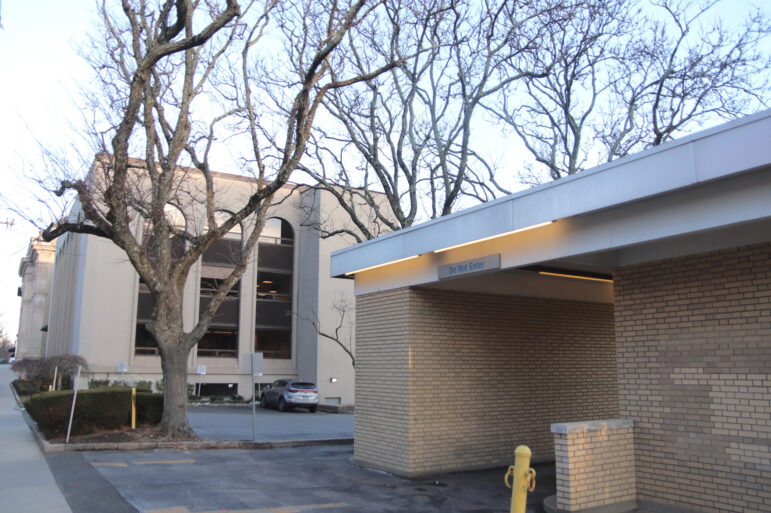
Neighbor Opposition: Harbor View Condominiums at 40 West Elm
The proposed parking plan talks about the 55 parking spaces dedicated to the commercial building with the bank and offices, and suggests residential tenants use those spaces when they come home from work at night and the bank and office workers are gone.
While parking does not have to comply with P&Z regs for an 8-30g, the commercial portion of the application does have to comply with zoning.
Mr. Cohen said the “pooled parking” on the 55 spaces was problematic on that basis.
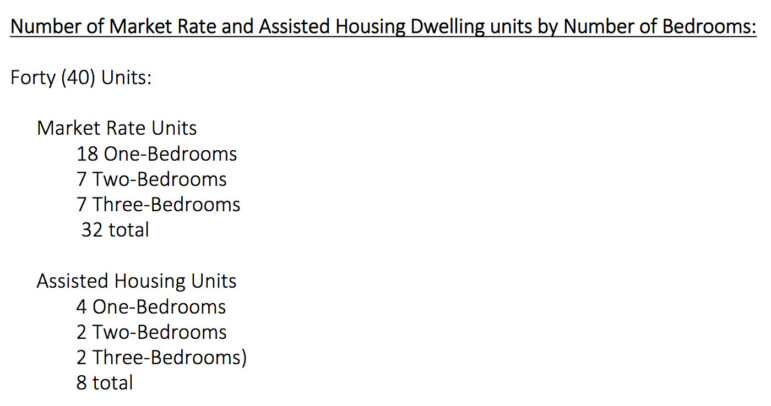
Forty residents from Harbor View signed a petition against the development, and many testified on Zoom citing multiple health and safety risks to both pedestrians and drivers.
Neighbors said the block was already very congested, with traffic backing up from intersections at both ends of the block, and there was an existing shortage of parking. They also said it was treacherous to cross at the crosswalk across from Benedict Place.
They said the building was too big and too close to 40 West Elm. Also that its FAR was too high and that is was ‘grossly under-parked.’
Jodi Stewart from Harbor View said she had almost been hit in the crosswalk to Benedict Place.
“Even after the bump outs were installed, the last thing we need is two stories worth of cars of 55 spaces or more being added to Elm Street and Greenwich Ave. It will further worsen safety for pedestrians and drivers on those streets.”
In a letter submitted as part of the public record, Peter DaPuzzo wrote: “This plan for a 40 unit assisted housing building would cause so many problems for pedestrians walking on West Elm and attempting to cross the street for one reason or another (go to Bank Of America, go for coffee in the new shop, go for lunch or dinner in Elm St. Oyster House). It is already very difficult to cross that street even with Connecticut State Law requiring autos to stop for pedestrians in crosswalk.”
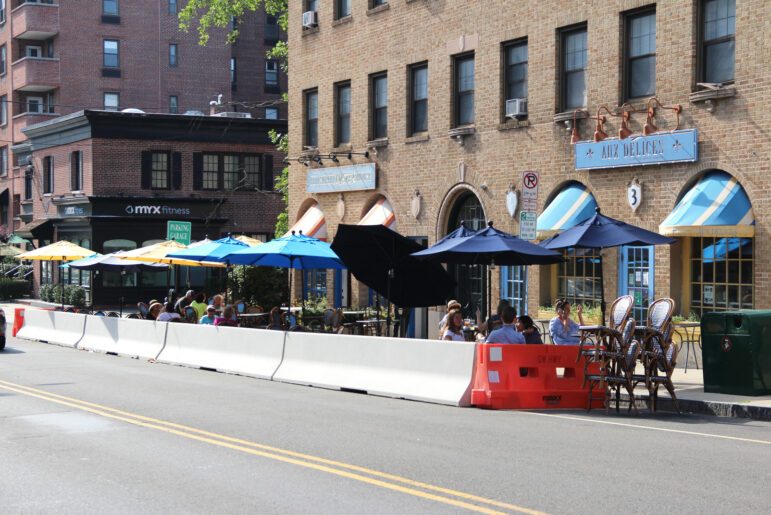
Mr. Cohen said the situation rose to a significant health and safety issue, including access for emergency vehicles, and that the neighbors had commissioned a peer-review from Mitchell Traffic Engineering.
“High on the list is absence of sufficient access for trucks and emergency vehicles. I think the turning templates the applicant submitted indicate clearly that for trucks of any size to access the property they’d be interfering with parking areas, ADA spaces and possible pedestrian routes,” Cohen said.
Mr. Tesei pushed back. “We submitted materials that demonstrate, statistically speaking, that this site can accommodate both the new building and the existing building’s expected parking needs, except on business days between 12:00 and 2:00pm, when it was one or two parking spaces short,” Tesei said.
“Parking itself is not a factor in an 8-30g application unless you get to the point of the issue of safety,” Tesei added. “Unlike some other 8-30g applications, our client is providing sufficient parking and the backdrop of having parking spaces available on the street for anyone. We don’t see that issue as getting anywhere near a safety or health issue criteria.”
Commissioner Nick Macri brought up a DPW traffic memo that talked about truck turning radius and movements in the street.
“We’re going to have moving vans and delivery vans – all kinds of things happening here at the same time,” Macri said, suggesting the applicant take another look at turning radii and impacts to West Elm Street.
Mr. Tesei said he didn’t think having vans and trucks moving people in and out of apartments came anywhere close to a safety issue that courts would flag under 8-30g.
“That to me sounds more like an excuse to me than a reason to deny an application,” Tesei added.
Still, commissioner Mary Jenkins said she was still troubled by the parking.
“You have 64 bedrooms but only need 40 parking spaces for the residential units. You’ve got a serious shortfall here,” she said. “Your traffic consultant talks about the availability of on-street parking or the availability of other parking lots in the neighborhood including town hall – I believe that is still an unsettled question.”
Signage at the town hall parking lot indicates it is for guests of town hall. The other parking lot at town hall is for employees.
“That section of West Elm is so congested,” Jenkins continued. “And it’s over-parked and double-parked now.”
“The congestion is bad, the pedestrian situation is not good. The sight lines are difficult on Benedict Place and on Field Point Road from West Elm,” Jenkins added. “I know it’s quote ‘only a parking issue,’ but it becomes a safety issue when you’re adding more cars in an area where there is already significant congestion.”
Mr. Tesei pushed back again, saying his traffic consultant’s study supported the application.
“They show statistically that the property actually works well and we’re not showing any meaningful off-flow. Are there occasions where it may happen? Yes it may happen,” Tesei said. “Most 8-30g projects cannot support the kind of parking that they need.”
Mr. Cohen said the application was premature because of a pending lawsuit.
He said Superior Court was scheduled to make a determination in October on whether a deed restriction that indicated residential uses would not be permitted on the property where the proposed building was proposed.
Ms Alban said a lawsuit would not hold up the application. She explained, for example, Greenwich Hospital did not withdraw their application for Smilow Cancer Center when there was pending litigation.
“They came in with a new application, but they did not withdraw their lawsuit on their first application,” she said.
Mr. Cohen said he believed that 8-30g simply did not apply to the application for two reasons.
First, that it called for changes to the existing commercial use that would make it more non-conforming, and second, that basing affordability off 80% of AMI did not qualify as assisted housing because the rules of the AHTF were not provided for in the state regulation.
As for the commercial use, he said existing commercial parking which is “grossly under parked” with only 55 spaces, would become even more non-conforming when shared with residential tenants with the expectation office workers leave in the evening when residential tenants come home from work.
He noted the plan was to add just 23 spaces new spaces for the 40 new units.
“I’ve never seen in my practice before the commission anything less than one space per unit for a residential multi-family apartment building,” Cohen said. “This seems to be deficient.”
Mr. Cohen said is the proposed parking arrangement would lead to people trying to park off site.
“I don’t think it will work out because it relies on the fact that there won’t be any activity at the bank on Saturdays and relies on the fact that people don’t work late in their offices, and possibly relies on the fact that right now the applicant hasn’t tenanted the office space and the bank has been closed for a while.”
Ms Alban noted the state’s affordable housing statute does not talk about a commercial element if it is included in an 8-30g application, and therefore the commercial use would have to conform to regulations. She said for the shared parking with the commercial tenants, the applicant would have to apply under 6-162 for site plan approval.
Alban said the commission would seek advice of legal counsel.
Mr. Cohen pointed out that the existing, convenient, at-grade commercial parking would be moved to basement or lowest level under the apartment building, representing a new change in the commercial site plan. And finally to make room for construction he noted the applicant would have to relocate and replace the ATM function.
“It’s shown on the plan that it will be placed in a location that happens to be interfering with the residential traffic on the site,” Cohen added.
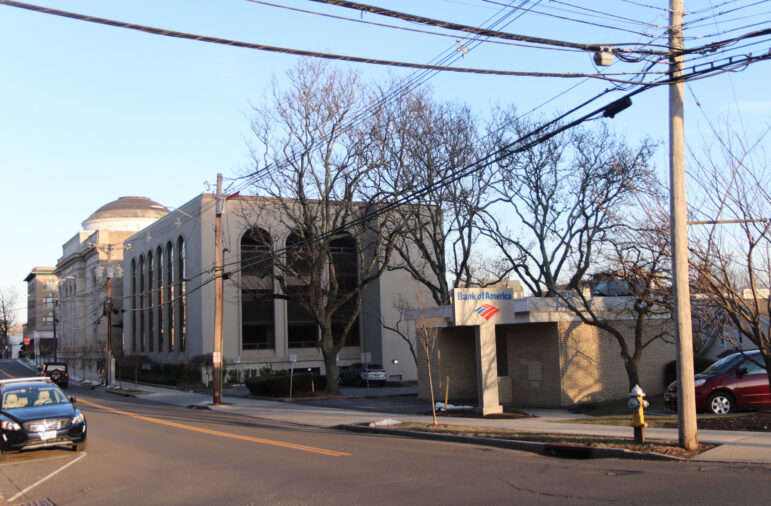
The second reason Mr. Cohen argued that 8-30g did not apply concerned the affordability plan.
He said he didn’t think the AHTF had the authorization to act as a town agency to determine whether the application met state criteria.
He said the rules were being made up by the AHTF as they went along and resulted in developers having a “free pass” and being allowed to “skirt the requirements of a set-aside development in the name of providing some level of affordability.”
P&Z commissioner Bob Barolak recused himself but participated in the conversation to the extent it impacted the Affordable Housing Trust Fund, of which he is chair.
“I think it’s clear and you would agree that the loan the trust is committed to giving this project is financial assistance?” Barolak asked.
“With respect I think it’s hogwash,” Mr. Cohen said, characterizing the $100,000 as not significant assistance on a project of the size proposed.
Mr. Cohen said using the standard of 80% of Area Median Income was appropriate didn’t qualify as assisted housing because the rules of the AHTF were not provided for in the state regulation.
“Twenty percent? Why shouldn’t it be 30% that you come up with for a set-aside development. And why 40 years. Why not perpetual?” he asked.
Ms Alban said under 8-30g, the language for set-aside developments had a level of specificity, unlike language for assisted housing.
Commissioner Dennis Yeskey said the commission would need an assurance the development was a qualified 8-30g application.
“The problem is that the state statute is silent in regard to many of these issues as to what constitutes assisted,” Alban said. “Our interpretation based on the views we have gotten is it allows this negotiation that is occurring.”
Mr. Barolak said it was within the purview of the AHTF to determine that 80% of AMI was appropriate.
Peter Malkin of Harbor View Condominiums, said he and his wife were long term residents and that issues of parking and traffic did rise to health and safety.
“Our position is that the inadequacy of parking, the poor design of entrance and exit, inability for emergency vehicles to get in and out of the property as designed were all serious health and safety issues,” Malkin said.
“Anybody who has been on West Elm Street knows there is no parking on the south side of the street, and very little parking left on the north side of the street because the town has enclosed what used to be parking spaces for the three restaurants on the street and now a substantial number of those patrons for those restaurants either park on this parking lot the applicant wants to develop, or double-park.”
He said without a provision for trucks to enter into the lot, there would be more congestion and double parking, in addition to issues with turning ratios an sight line issues.
He also questioned the shared parking plan with the commercial spaces.
“One of the things that strikes me as really odd is the assumption that from 9-5, five days a week none of the residents will have their cars in the lower level parking area. If they choose to stay home and leave their cars there, where do the commercial users get the 55 parking spaces?”
Mr. Malkin said avoiding the rule of lower income SMI by taking the higher, AMI, clearly contradicted the purpose of 8-30g.
“I doubt that the AHTF constitutes a governmental entity,” Mr. Malkin said. “It may be authorized by the Town of Greenwich but it is not the Town of Greenwich. It has a separate board and is not a town agency.”
Steven Mitchell, the consulting traffic engineer for the neighbors, blasted the proposal on three fronts: traffic impacts, parking and site circulation.
First, he disagreed with the applicant’s position that they were reducing traffic.
“Unfortunately, they did a number of things incorrectly in trying to do these calculations. Primarily they used the ITE trip generation report, but an outdated version.”
“They used square footages in their traffic statement that I cannot confirm,” he added. “Basically none of the numbers add up.”
He said some of the traffic calculations were done incorrectly. “They eliminated certain pieces of square footage that you’re not allowed to eliminate. Basically every traffic engineer knows that,” he said. “I could not replicate their position that they are reducing traffic.”
As for on-site parking, Mr. Mitchell noted that while the existing parking for the commercial building was non conforming at 55, it should generate about 133 parking spaces.
“They talked about they’re improving the parking. They are adding 23 parking spaces and adding 40 residential units. That’s only a slight bit more than a half a space per unit.”
“They also made a fundamental error in their parking calculations by looking at the residential parking as ‘low rise residential,’ but by ITE definition it was ‘mid-rise residential,'” he added.
Mr. Mitchell said an SU-30 truck entering the building would run over the curbs on the other side of the street, run over handicap ramps and curbs on both sides of the road, and even brush against the side of the ATM.
“That’s just him to get in and out. What he does once he’s in there I don’t know because there is nowhere for him to stop and park to unload.”
Arn Welles noted the state was encouraging towns to build housing near the railroad station. He asked whether Mr. Mitchell had taken into account the proximity to the train and whether people felt they didn’t need a car.
Mr. Mitchell said, “While Greenwich had many urban characteristics, you can’t do all your shopping on Greenwich Avenue….You end up needing a car and you’ve got 40 apartments.”
“This site plan as shown will create a serious adverse impact on public health and safety both on the site and in the immediate vicinity,” Mitchell said.
Mr. Tesei said he anticipated objections to be raised.
“Mr. Cohen made it crystal clear that no matter what project was proposed that had a residential component would be opposed vehemently, and it’s been true right along,”Tesei said. “We started with actually even a smaller building three years ago and held out numerous olive branches to them and they weren’t interested.”
Tesei noted that after they came in with a 60-unit application last summer, the P&Z commission suggested the applicant go to the AHTF, which they did. He said Mr. Fareri had reluctantly agreed to reduce the size of the building to 4 stories instead of 6 stories of residential use.
As for the pending litigation, he said it had to do with rights, not zoning, and that at the upcoming hearing the “issues would be put to bed satisfactorily.”
“Our client has the full right to develop this portion of the property,” Tesei said. “So long as it complies with the building code and obtains a certificate of occupancy.”
As for shared parking with the commercial use, he said the applicant would be willing to have it work as efficiently as possible either by signage or by managed parking.
Moreover, Tesei said, “Parking, or the lack of parking, is not under 8-30g a life-safety factor. It’s like no good deed goes unpunished for providing parking.”
He said his consultant would provide a written response to Mr. Mitchell’s analysis.
“We don’t believe he took the proper credits in his chart for an urban setting and the type of parking we have here that is shared,” Tesei said. “Experts always differ as we know and it’s funny they are usually on the side of the person who paid them.”
Ms Alban said the commission would have to reconcile the different opinions and get interpretations on the statutory interpretations.
She said the commission would also go back to the town’s consultant, BETA Group with Mr. Mitchell’s analysis.
And we’re going to talk to counsel for statutory interpretations on the disagreements between Mr. Cohen and Mr. Barolak.
Alban said she also wanted to return to the Fire Department about the turning radius issues.
The item was left open.